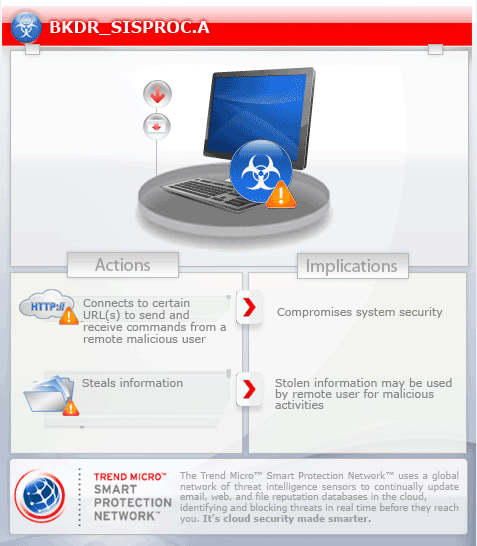BKDR_SISPROC.A
Trojan:Win32/Comame(Microsoft)
Windows 2000, Windows Server 2003, Windows XP (32-bit, 64-bit), Windows Vista (32-bit, 64-bit), Windows 7 (32-bit, 64-bit)


Threat Type: Backdoor
Destructiveness: No
Encrypted: No
In the wild: Yes
OVERVIEW
Dropped by other malware
This backdoor is the detection for malicious attachments in email messages that spoof the 2013 G20 Summit in Russia. Users with systems affected by this malware may find their personal information stolen and the security of their systems compromised.
To get a one-glance comprehensive view of the behavior of this Backdoor, refer to the Threat Diagram shown below.

This backdoor may be dropped by other malware.
It executes commands from a remote malicious user, effectively compromising the affected system.
It deletes itself after execution.
TECHNICAL DETAILS
41,998 bytes
EXE
Yes
21 Aug 2013
Steals information, Connects to URLs/IPs
Arrival Details
This backdoor may be dropped by the following malware:
- LNK_SISPROC.A
Installation
This backdoor drops the following copies of itself into the affected system and executes them:
- %Application Data%\svchost.exe
- %ProgramData%\winupsvc.exe (for OS versions Windows Vista and higher)
(Note: %Application Data% is the current user's Application Data folder, which is usually C:\Documents and Settings\{user name}\Application Data on Windows 2000, XP, and Server 2003, or C:\Users\{user name}\AppData\Roaming on Windows Vista and 7.. %ProgramData% is a version of the Program Files folder where any user on a multi-user computer can make changes to programs. This is usually C:\ProgramData in Windows Vista and 7, or C:\Program Files on Windows 2000, XP (32-bit), and Server 2003, or C:\Program Files (x86) on Windows XP (64-bit).)
It adds the following mutexes to ensure that only one of its copies runs at any one time:
- c02b5fb4
Autostart Technique
This backdoor adds the following registry entries to enable its automatic execution at every system startup:
HKEY_LOCAL_MACHINE\SOFTWARE\Microsoft\
Windows\CurrentVersion\Run
Internet Explorer = "%Application Data%\svchost.exe"
HKEY_CURRENT_USER\Software\Microsoft\
Windows\CurrentVersion\Run
Internet Explorer = "%ProgramData%\winupsvc.exe" (for OS versions Windows Vista and higher)
Backdoor Routine
This backdoor executes the following commands from a remote malicious user:
- Download and install plugin
- Uninstall itself
- Log off
- Restart the system
It connects to the following URL(s) to send and receive commands from a remote malicious user:
- {BLOCKED}.{BLOCKED}.241.110:80
- {BLOCKED}.{BLOCKED}.153.157:443
- {BLOCKED}.{BLOCKED}.153.157:8080
Information Theft
This backdoor gathers the following data:
- Host Name
- OS Version
- Local IP Address
- User Name
Other Details
This backdoor deletes itself after execution.
NOTES:
This backdoor queries the following registry entry to check the installed operating system:
HKEY_LOCAL_MACHINE\SYSTEM\CurrentControlSet\Control\ProductOptions\ProductType
SOLUTION
9.300
10.230.03
21 Aug 2013
10.231.00
22 Aug 2013
Step 1
Before doing any scans, Windows XP, Windows Vista, and Windows 7 users must disable System Restore to allow full scanning of their computers.
Step 3
Restart in Safe Mode
Step 4
Delete this registry value
Important: Editing the Windows Registry incorrectly can lead to irreversible system malfunction. Please do this step only if you know how or you can ask assistance from your system administrator. Else, check this Microsoft article first before modifying your computer's registry.
- In HKEY_LOCAL_MACHINE\SOFTWARE\Microsoft\Windows\CurrentVersion\Run
- Internet Explorer = "%Application Data%\svchost.exe"
- Internet Explorer = "%Application Data%\svchost.exe"
- In HKEY_CURRENT_USER\Software\Microsoft\Windows\CurrentVersion\Run
- Internet Explorer = "%ProgramData%\winupsvc.exe"
- Internet Explorer = "%ProgramData%\winupsvc.exe"
Step 5
Restart in normal mode and scan your computer with your Trend Micro product for files detected as BKDR_SISPROC.A. If the detected files have already been cleaned, deleted, or quarantined by your Trend Micro product, no further step is required. You may opt to simply delete the quarantined files. Please check this Knowledge Base page for more information.
Did this description help? Tell us how we did.

